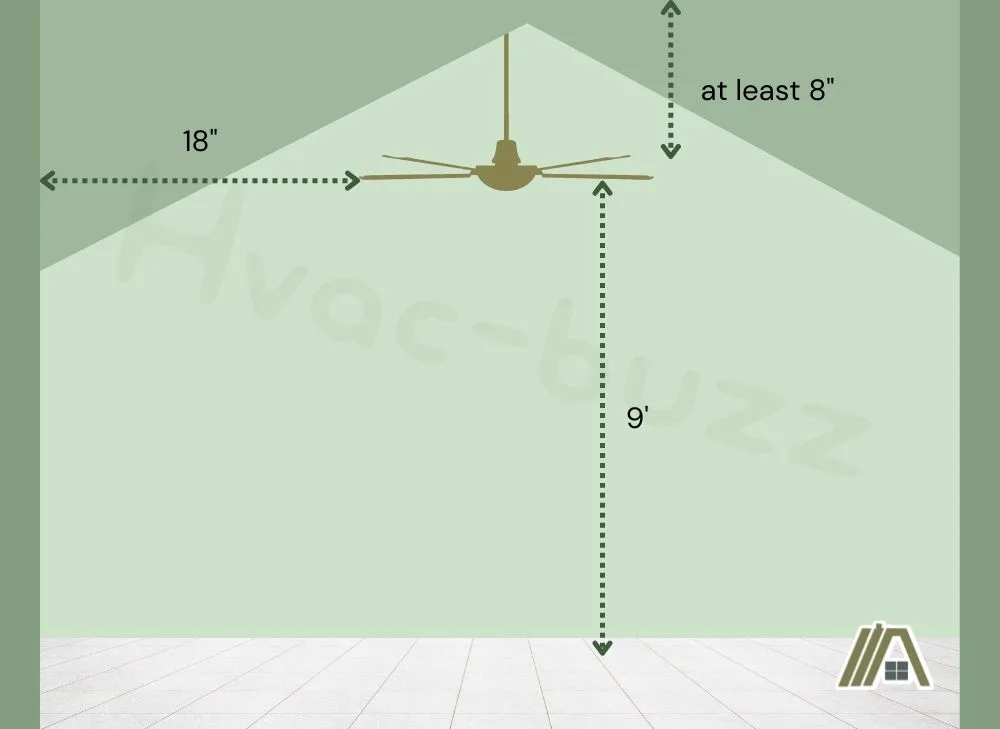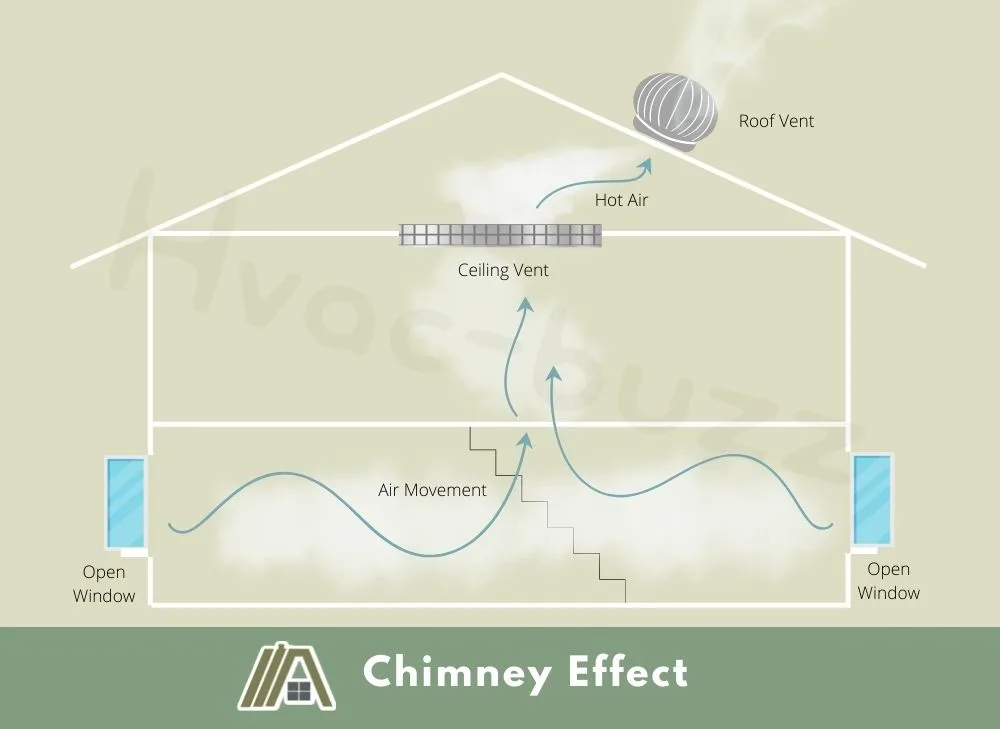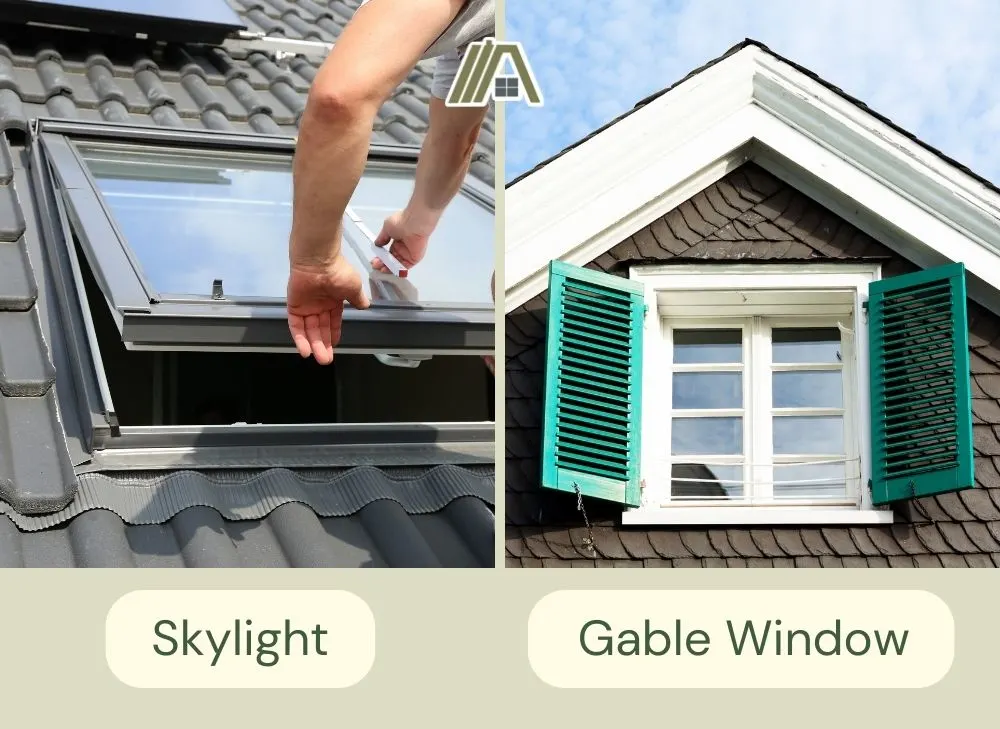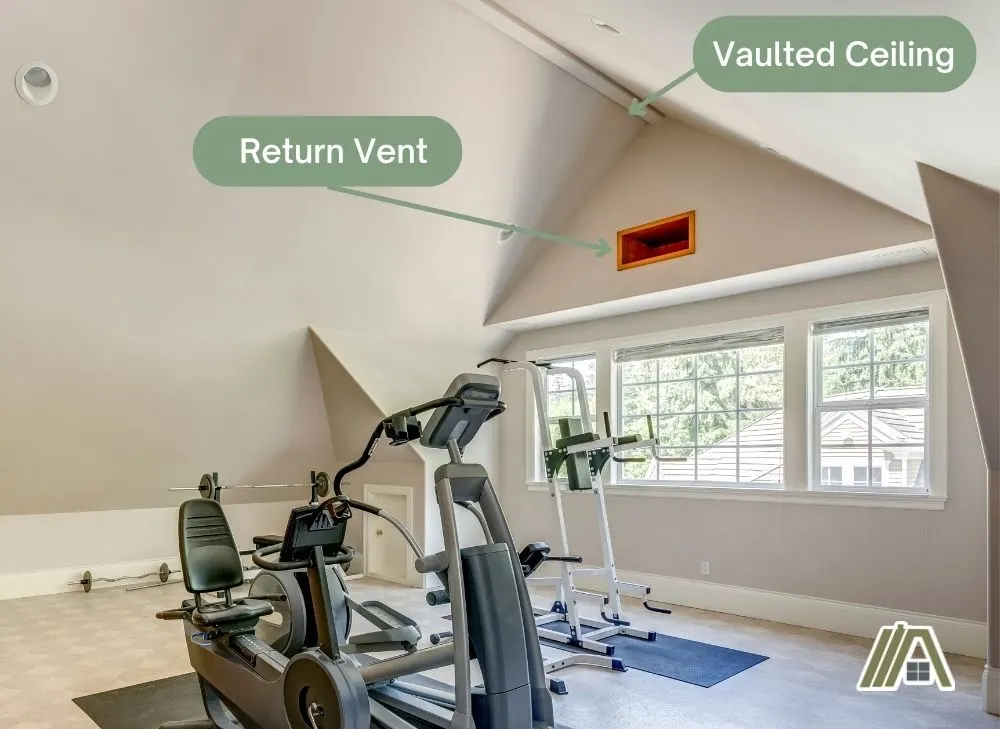Vaulted ceilings are a lovely architectural addition to your home. However, they are known for sequestering heat near the ceiling and hindering efforts to circulate air throughout the room.
It is not impossible to circulate air effectively in a vaulted ceiling. Energy savings can even be achieved by considering air’s tendency to rise and fall. However, extreme temperatures can make your goal, whether it is to heat, cool, or circulate air, a bit more difficult to achieve.

There are various ways to circulate air in vaulted ceilings:
- Install a ceiling fan
- Open vents, windows, and doors to create the chimney effect
- Install skylights or gable windows
- Place air circulators in the room
- Add HVAC returns and registers
Install a Ceiling Fan
Although rooms with vaulted ceilings may be similar in square footage to other rooms in the house, the added height of the room increases the volume of the room a significant amount.
In general, if you were to choose a ceiling fan to circulate air in a room with vaulted ceilings, the fan should have a higher airflow rating to ensure that the air moves far enough into the room. Otherwise, you create air circulation in the vaulted area as if it were a room of its own.
For optimal performance, a ceiling fan should also meet ceiling fan clearance requirements. A ceiling fan should be at least 8″ from the ceiling, 18″ from walls, and 9′ from the floor to ensure optimal airflow. Although, going too far beyond the 9′ floor clearance can also cause issues.

It would be beneficial for a ceiling fan in a room with vaulted ceilings to feature a downrod or even an extender rod so that the ceiling fan hangs lower than eight inches.
The more space between the ceiling and the fan, the more efficient the airflow production.
Ceiling fans should also be placed as close to the center of the room as possible. This ensures that the entirety of the room is feeling the effects of airflow rather than just one corner or side.
Why Are Ceiling Fans a Good Option?
Ceiling fans can provide a cooling mechanism with and without the aid of air conditioning. The movement of air in summer mode (downward flow of air) creates wind chill, which cools your body by increase heat loss through the skin.
The counterclockwise rotation of ceiling fans (summer mode) creates general air circulation. As the air is pushed down, it displaces air lower in the room, which then moves out and up. From here, it is pulled into the fan and pushed down, and the cycle begins again.
Ceiling fans are relatively inexpensive to purchase, the running cost is near negligible, and they are going to last you a long time, particularly with good maintenance.
In addition, there are so many options to choose from in terms of look and design.
Limitations of Ceiling Fans
Although ceiling fans can do very well in cooling a room, especially with the aid of an AC unit, they can come up short when the areas become too large and the temperatures become too cold or extreme.
Ceiling fans are labeled with an airflow rating in CFM, meaning the cubic feet of air moved per minute.
Once your room surpasses a certain size, some CFMs are too small, and not enough air is moved for the whole room to be positively affected. This is more of a problem for rooms with vaulted ceilings since they are often larger than most rooms, and the fan is far away from the areas occupied by people.
You can counteract this by buying a bigger fan, but this can only help up to a certain extent.
Installing the fan lower down can also help, and is actually the recommended approach, but it means you give up an heating benefits of the reverse rotation.
In winter mode, ceiling fans are supposed to pull cold air up away from the occupied space and use it to displace warm air that has risen to the ceiling. This warm air then moves down into the occupied spaces.
When you set the ceiling fan lower, you limit its influence over the air right against the ceiling. You should note that the heating benefits of ceiling fans are only normally felt when used in conjunction with a heat source.
Winter mode also has a more gentle airflow, meaning the air might not have enough momentum to reach all the way from the vaulted ceiling to the occupied spaces of the room.
You would have to get a remote-controlled ceiling fan because it’s obviously impractical to require a chain pull switch to turn it on and off!
Installation and maintenance are also going to be tricky in vaulted ceilings.
Create Passive Flow of Air Through Whole House
The concept of passive ventilation is based on the natural sinking and rising of air when it varies in temperature.
Rather than actively ventilating the home through devices like ceiling fans, the natural movement of air is relied upon in this technique.
Warm air naturally rises and through the process of passive ventilation, warm air would rise from the basement, through the vaulted ceiling, through the attic (if it extends over the vaulted ceiling), and will then disperse into the outdoors.
In order for this mechanism to work, the room with the vaulted ceiling must not be isolated from the rest of the home. Rather, it must easily be incorporated in to the natural path of the air.
Mechanism of Passive Airflow
The mechanism of passive airflow creates a vacuum-like effect known as the chimney effect that not only facilitates the removal of warm air but also facilitates the distribution of cool air.
To achieve an effective chimney effect, you will need to open (or install and open) attic/roof vents. You would also need to open the windows and/or doors on the lower floors.

Cool air naturally sinks, so it gathers in the lower regions of rooms and also the house as a whole, which is why basements are most often the coldest rooms in houses.
Attics are often the warmest because hot air naturally rises.
If this hot air was allowed to escape through the attic/roof vents, then it would create a vacuum in the upper regions of the house. The air in the lower regions would be pulled up to eliminate the vacuum.
The air in these lower regions is then replaced with outside air as a result of the open windows and doors here. If these were not open, then the air would not leave the attic or be pulled through the house as effectively.
While the entrances and exits for air are important, open doors along the way are also important to remove obstacles from upwards airflow and ensure that the vaulted ceiling is part of this pathway.
Why Is Passive Airflow a Good Option?
If passive airflow is used well, it can be an incredibly cheap and easy way to cool your home.
By incredibly cheap, I mean absolutely free.
As long as your home is not using air conditioning, since letting air conditioning escape through windows and doors would be a loss of money, ventilating your home passively will greatly reduce your energy bills.
The only expenses would be if you have to install vents in your attic or roof to improve the passive airflow process.
As far as general air circulation, passive airflow utilizes air’s natural tendency to rise and fall to keep air moving through the entire home.
There are also no maintenance requirements for this kind of airflow.
Limitations of Passive Airflow Systems
Although this process can be incredibly cheap and great at cooling the home, it is useless when it comes to warming the home.
Since the entire passive ventilation process is centered around warm air rising and escaping and cold air being brought in and redistributed, it cannot be used to warm the home in colder months.
With extremely high temperatures, passive airflow will circulate the air in your vaulted ceiling but it may not be able to cool the home enough to make it comfortable.
So, as far as air circulation, passive airflow does a decent job at keeping air moving, but it is not as effective as active systems.
Install a Skylight or Gable Window
Both skylights and gable windows can be aesthetically pleasing additions to your home that can also introduce air circulation.
While a skylight/gable window is open, air enters the home and can exit as well.

Because the windows are situated higher in the home, in this case, on the vaulted ceiling or on the wall in the vaulted section, this can allow for warm air that has risen and become stuck near the ceiling to exit the home. This will pull air up through the room, creating air circulation.
Also, if the outside temperatures are cool enough, for example, in the evening or at night, cooler air can enter the home and naturally sink to cool the room with the vaulted ceiling, creating airflow as it does this.
This process would be similar to passive airflow but the airflow would be isolated to one room for the most part. In some cases, this can be more to the point.
Why Are Skylights or Gable Windows Good Ideas?
Along with creating air circulation in the room, skylights and gable windows introduce natural light to the room and can make a beautiful addition to the home.
Because utilizing skylights/gable windows is a form of passive airflow, the cooling process does not use energy.
Skylights, particularly, are great at removing warm air from your vaulted ceiling. Because they are in the ceiling rather than the wall, air will naturally rise through the skylight rather than getting stuck at the ceiling.
Limitations of Skylights and Gable Windows
Gable windows are not as effective at removing warm air as skylights because they are not on the ceiling. This means that warm air will not naturally rise out of the window, but rather will settle near the ceiling instead.
The installation of skylights and gable windows can be expensive and are also an invasive and big change to your home.
Because this is a form of passive airflow, the air circulation, as well as the cooling capabilities of this process, are limited.
As with some other air circulation methods, extreme temperatures will hinder their success.
A similarity shared with passive airflow is that this process will not aid in heating a home. This is because airflow relies on hot air naturally escaping and cold air being drawn up.
Place Air Circulators In the Room
Before getting into the effectiveness of air circulators, it is important to first distinguish between air circulators and fans.
Where fans produce a unidirectional column of fast-moving air, air circulators produce a rotating and widening stream of fast-moving air. Air circulators also have a better reach, pushing air further from the device than a similarly sized fan.
Fans utilize the wind chill effect as the main cooling mechanism and can eliminate hot and cold pockets to some extent. Air circulators produce a less noticeable current of air, so wind chill is limited, but they are far better at providing air circulation and eliminating pockets of hot and cold air.
In short, fans and air circulators are similar but air circulators are much more effective at introducing steady airflow throughout the entire room.
Air circulators can be great additions to a space with a vaulted ceiling because, when aimed up, they can eliminate the hot pockets of air that are stuck at the ceiling.
Why Are Air Circulators a Good Idea?
Air circulation and heating or cooling are different. If you are only looking to circulate air in a vaulted ceiling, then a fan may produce unwanted cooling. Air circulators will create airflow in the vaulted room without making you feel colder.
The far reach of the column of air is ideal for tall ceilings and you can reach them without having to install anything in the hard-to-access vaulted ceiling area. The air circulator can be placed on the ground or a table and aimed up to provide air circulation.
If used with a heater, the heat can be effectively distributed. Simply eliminating cold spots near the floor can also make the room feel warmer.
They are portable and can be stored when not in use.
Limitations of Air Circulators
Air circulation is greatly enhanced by an air circulator but cooling and heating can be lacking.
Having the air circulator in the room can be an eyesore. It can also be annoying if you have no place to conveniently store it while it is not in use.
These devices are a newer technology, so in terms of style and design, your options will be quite limited.
Add HVAC Returns/Registers Near or on the Ceiling
All of the methods discussed so far incorporate strategies that do not directly involve your HVAC system.
However, properly circulating air in a room with vaulted ceilings can be accomplished by utilizing your existing HVAC system. All you would need to do is add return vents and registers in the vaulted area of the room.

Return vents in this area can help to pull hot air out as it rises, creating a chimney effect that pulls air up and, thus, introduces air circulation.
Registers that add air here will also displace air down, which helps to keep air moving in the vaulted area, preventing it from becoming stagnant.
With regards to the heating and cooling benefits or these added returns and registers, it depends on the season.
When you add cold air and remove hot air (summer), then the vents are great because hot air rises to be removed and cold air sinks into the occupied space.
When you add hot and remove cold air (winter), then the vents are less ideal because the heating benefits require the air to act contrary to its nature. You want the hot air to sink and the cold air to rise.
While this can be achieved through general air circulation and other returns and registers, it’s far less effective.
It is important to note that register and return vents cannot be added without considering the repercussions. HVAC systems have carefully balanced pressure systems and new vents can upset this balance if not done properly.
Why Are Returns/Registers a Good Idea?
Vents provide effective air circulation and are connected to the HVAC system, so it’s not a separate system you have to try to manage or include.
For example, if you have skylights, you have to consider that the cooled air supplied by the AC is going to escape outside. This is not an issue with the additional HVAC vents.
They can be very inconspicuous so high up, so the aesthetic of the room is not affected as much as it is with the other methods.
Limitations of HVAC Vents/Registers
Less effective at providing air circulation in winter when the supplied air is warm.
Installation is invasive and can have systemic repercussions if not done properly.
Vents require a certain level of maintenance, which is difficult to do when they are placed so high up.
Sources
https://solarinnovations.com/our-products/aluminum-skylights/operable-skylights/venting-skylights/


